Home Recording Guide For Rock And Metal –
Part 2: Studio Gear
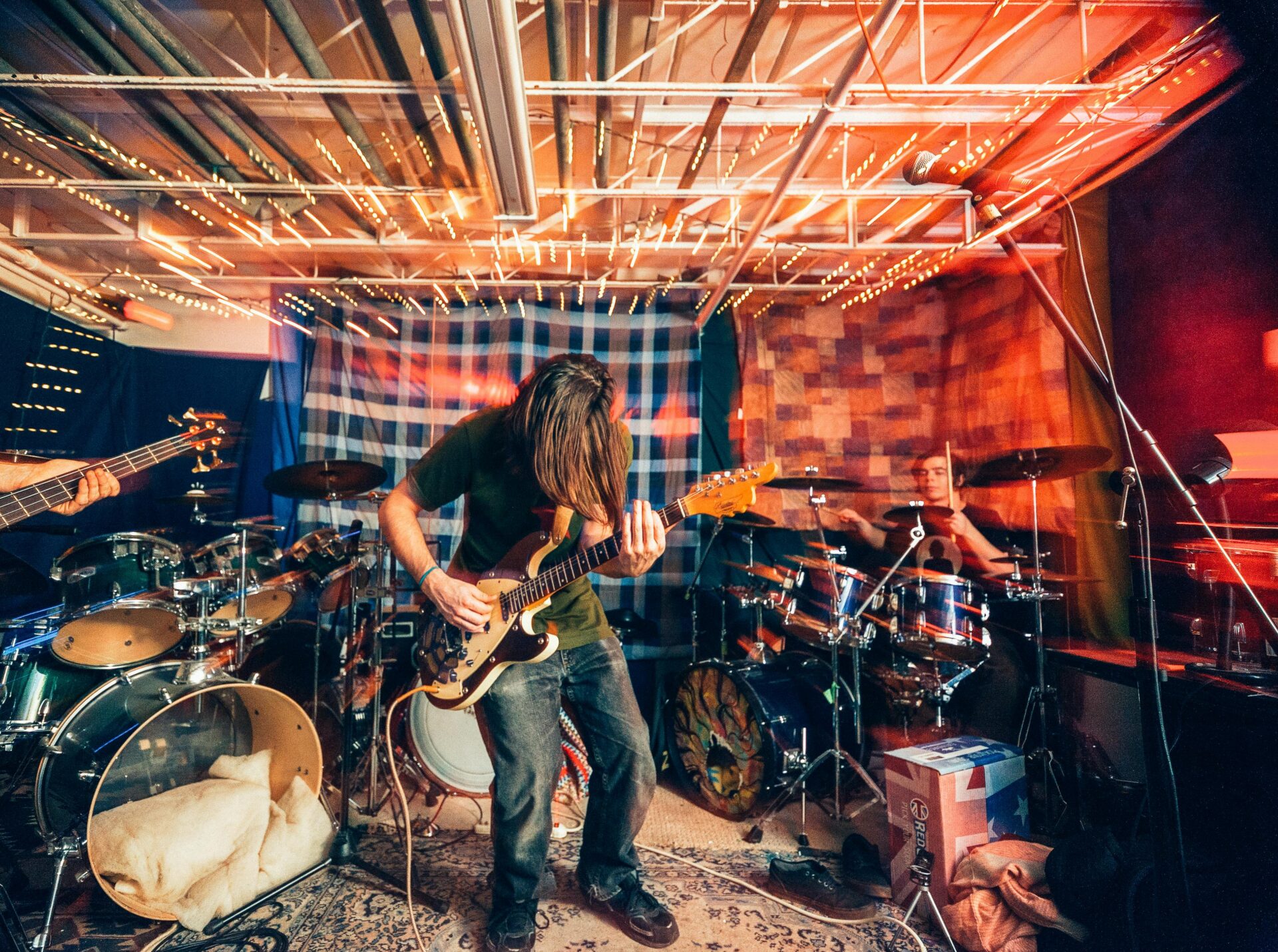
Setting up a home studio to self-record your band’s music can be daunting. There’s so much gear to choose and so much room to mess things up. In the second part of the Home Recording Guide we’re going to look at which components a basic recording setup needs and what to look for when choosing them.
1. The Room
Yes, this is also a studio component, and while it’s arguably one of the most important ones as well, it’s often overlooked in home studio settings.
With home studios (or band practice spaces used for recording) the choice of physical spaces is often very limited. Before you start setting everything up, it’s still a good idea to have a concept of how you’re planning to make use of the room (or rooms) at your disposal.
Here are some criteria to think about if you can decide between different rooms:
- Availability: Is the room easily available whenever you need it? Do you need to share the room and plan accordingly?
- Size and room geometry: Avoid square rooms, low ceilings, very small rooms, large areas of glass.
- Acoustics: Is the room already sounding dry because of the furnishing, e.g. a couch etc.?
- Surrounding noise: The goal of course is a quiet room with minimal noise from outside.
- Soundproofing and possible disturbance of neighbors.
While you’re at it, you can also check out my room acoustics tips for vocal recording.
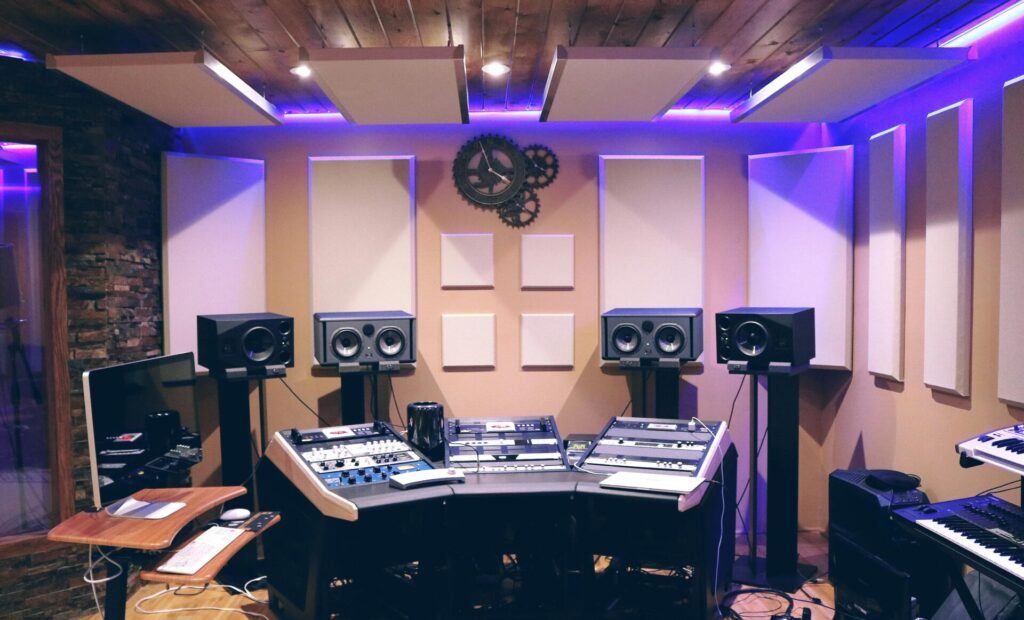
2. Acoustic treatment
Once you’ve chosen the best room possible, it’s likely still not optimally set up for recording yet. This is where acoustic treatment comes into play to get the most out of your recordings.
With acoustic treatment, more is generally better. Especially in small rooms and rooms that weren’t purposely built for studio use, you can’t really have enough anyway. In practice, it’s more about how much treatment you can and/or are willing to afford.
For the most efficient acoustic treatment of your room, try to implement the following points:
- No large blank areas on walls / ceiling / floor, especially directly opposing each other.
- Use absorption panels…
- at the first reflection points of the studio monitor setup. (= points on the walls where you would see the speakers in a mirror from the listening position)
- on large reflective areas that are left (walls, floor, ceiling)
- with a minimum thickness of 4” / 10 cm (ideally).
- Build a makeshift “vocal booth” in a corner by placing thick absorption material on both sides of the corner, with the mic facing the “dead” corner.
Follow this link for a more detailed guide on how to optimize room acoustics for vocal recording.
- Bass absorption in the corners: Rockwool or natural fiber bass traps, as large as possible, covering the full height of the room. Either self-built or pre-made units.
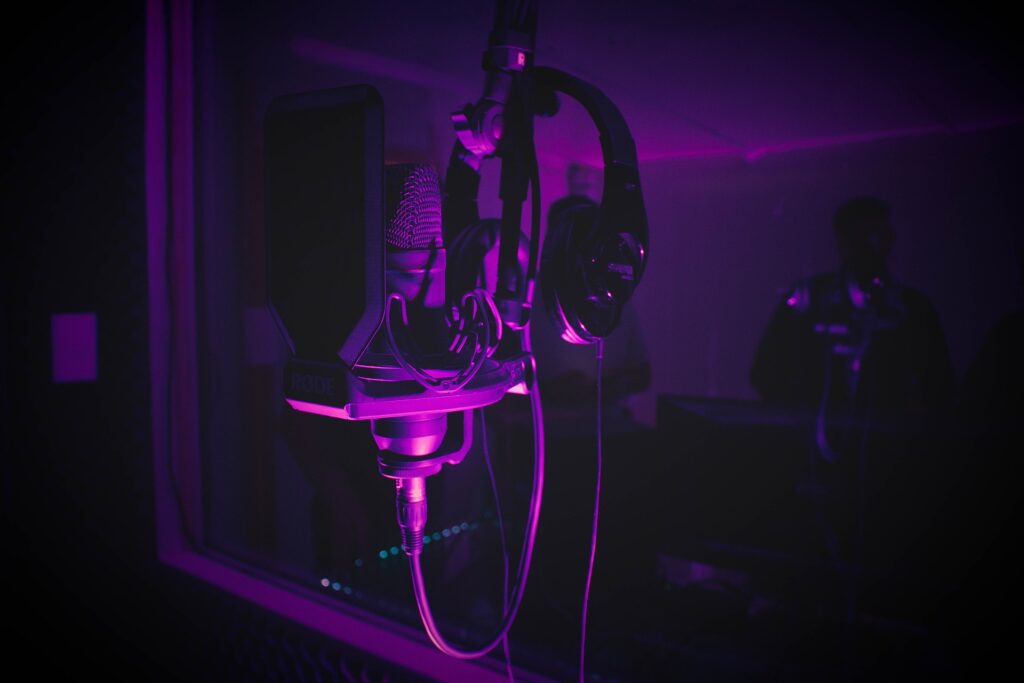
3. Microphones and DI boxes
Now we get into the “actual” studio gear. The most obvious part of that is microphones. For band recording however, you probably also need a good DI Box for guitars and bass, depending on how you record them. Let’s go through all signals you typically deal with in a rock or metal setting and what you would generally use on each of them:
3.1 Drums
- Kick:
- dynamic mic like the Sennheiser e902, Audix D6, AKG D112 (or similar) and/or
- PZM / boundary mic (condenser) like the Shure Beta 91A or Sennheiser e901
- Snare: dynamic mics for top and bottom, e.g. Shure SM57, Beta57, Beyerdynamic M201, Audix i5
- Toms: dynamic mics like the Sennheiser e604 or similar. Some special condenser mics are also good, like the Beyerdynamic TG D57c / D58c
- Hi-Hat: Small diaphragm condenser (like Overheads) or even any dynamic mic (like an SM57)
- Overheads: Small diaphragm condenser mics; recommendations: AKG C451, Sennheiser e914, Shure SM81, SM94, SM137, SE Electronics SE8, SE7, Lewitt LCT 140
- Room mics (if your room sounds good): A pair of large diaphragm condensers like the Rode NT-1A, Audio Technica AT2020 or similar. See also section 3.4 Vocals!

3.2 Bass

- DI (Direct Input): Plug the bass either directly into the audio interface’s instrument input or put it through a good DI box. Recommendations: Radial Pro 48 (active), Radial Pro DI (passive). Use the “through” output of the DI box to connect your usual pedal/amp rig if needed. You can also use the same DI box when recording real guitar amps/cabs.
- Distortion pedals: If you use any kind of distortion pedal or other effects for your bass sound, use a DI box to record the direct signal as well and connect the “through” output to your usual rig. Then plug the output of your signal chain into your interface (either a line input if it’s a line output from a bass preamp, or an instrument input).
- Mic: Generally I would recommend to just not bother with recording a real bass amp/cab for modern styles of music. If you really want to, just use a dynamic “kick mic” (see drums), and always record a DI as well.
3.3 Guitars
- A typical dynamic “snare” mic will work well on a guitar cab too. (SM57 or similar)
- If you record real amps/cabs, always use a DI box to record the direct signal as well.
- If you only use virtual amps/cabs, you can of course just plug the guitar into your interface’s instrument input or use a good DI box.
- For acoustic guitar, you can use the same mic as you would use as a drum overhead, a small diaphragm condenser.
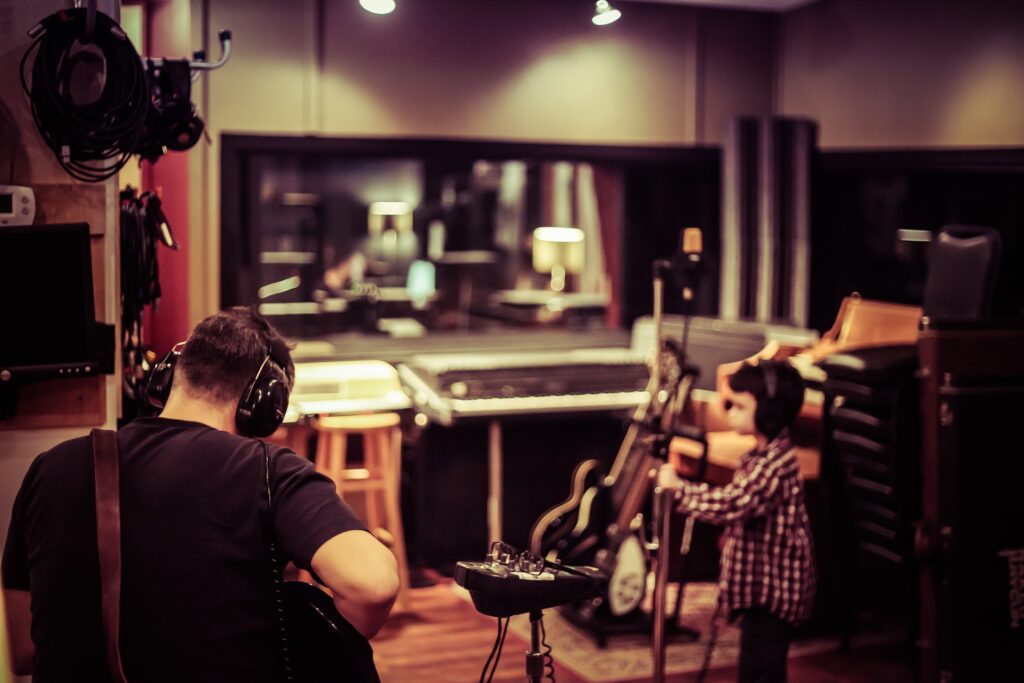
3.4 Vocals

The typical studio mic for vocals is a large diaphragm condenser, however a good dynamic mic can work very well (or even better) for heavier styles of music. Some Recommendations:
- SM7B (dynamic)
- Aston Origin
- Lewitt LCT 440 Pure
- Rode NT-1A
For an in-depth guide on How To Find The Right Studio Vocal Microphone For Your Budget, click this link.
3.5 Analog Synthesizers, Keyboards etc.
Other instruments with a line-level output like synthesizers, keyboards, samplers etc. can easily be recorded either through a DI box or the interface’s line input.
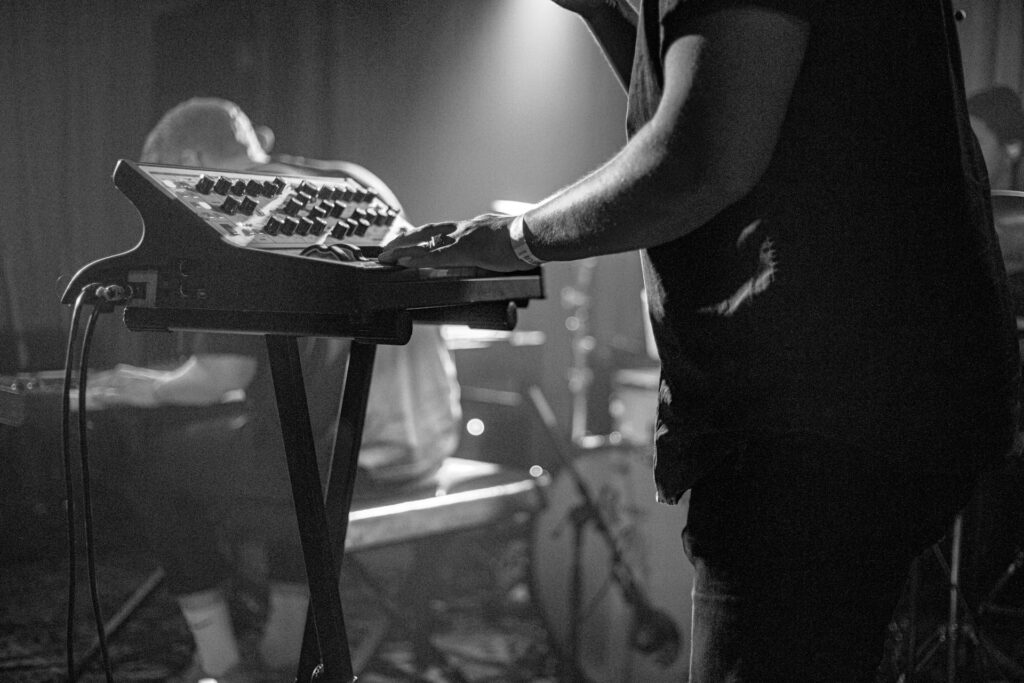
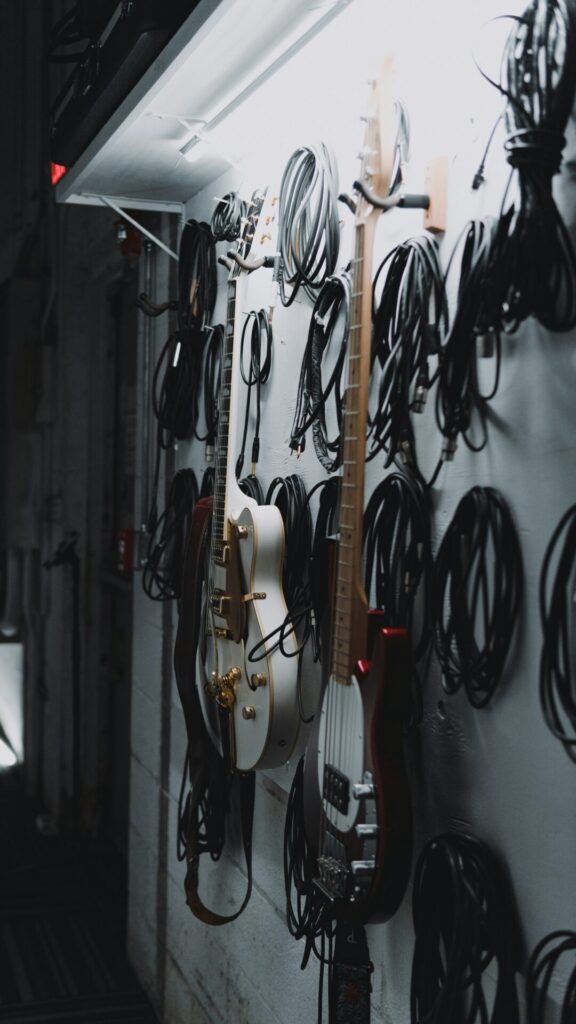
4. Cables
You don’t need to obsess over the quality of your cables. As long as you’ve got decent ones, you’ll be absolutely fine. This basically means: Buy cables from a well-assorted music store and just don’t get the cheapest ones there. The kinds of cables you definitely need for band recordings are:
- Mic cables (XLR)
- Line cables with a 1/4” TRS jack (“stereo” jack, but for one channel!) for line-level instruments (Keys etc.)
- Instrument cables for guitar/bass. Keep those as short as possible, preferably between 1.5m and 3m.
Keep all cables as short as possible to maintain the best signal quality. In home studios 5 m (15 ft) to 10 m (30 ft) are usually right.

5. Audio interface, preamps, converters
The interface, mic preamps and converters together form the heart piece of a modern home studio. Fortunately for most budget studio builds, the audio interfaces in question almost always already have built-in preamps with converters. Quality-wise, the built-in preamps are good enough for all home recording purposes. The only reason to buy separate preamps is if you need more simultaneous recording channels for recording drums. A good starting point for a budget studio aimed at full band recording:
- 8-Channel interface if you want to record acoustic drums
- 2- or 4-channel interface if you don’t record drums yourself
- Optional: another 4- or 8-channel mic preamp that connects to the interface via ADAT (optical)

6. Computer
The interface, mic preamps and converters together form the heart piece of a modern home studio. Fortunately for most budget studio builds, the audio interfaces in question almost always already have built-in preamps with converters.
Quality-wise, the built-in preamps are good enough for all home recording purposes. The only reason to buy separate preamps is if you need more simultaneous recording channels for recording drums. A good starting point for a budget studio aimed at full band recording:
- 8-Channel interface if you want to record acoustic drums
- 2- or 4-channel interface if you don’t record drums yourself
- Optional: another 4- or 8-channel mic preamp that connects to the interface via ADAT (optical)
6.1 Recommended specifications
- PC or Mac
- 16 or 32 GB of RAM
- Intel i5, i7 or i9 processor, AMD Ryzen 5, 7, 9 or Apple M series
- Good air flow, quiet fans
- Sufficient connectivity for all your devices (interface, mouse/keyboard, other peripherals)
6.2 Optimization Quick Tips
The following points are the most efficient ways to optimize your computer system for audio work (real time performance).
- Only connect the devices that you need for studio use. Every additional device will increase the likelihood of audio dropouts, clicks, pops and random CPU usage peaks when using low buffer sizes for low latency.
- Always keep your system updated. However:
- avoid updating studio software in the middle of a project to minimize compatibility issues and
- avoid major system updates that aren’t security-related when you’ve got unfinished important projects.
- Deactivate unnecessary background tasks/apps.
- Deactivate unnecessary system features.
- Deactivate system sounds.
- Deactivate all power saving features and enable maximum performance mode.
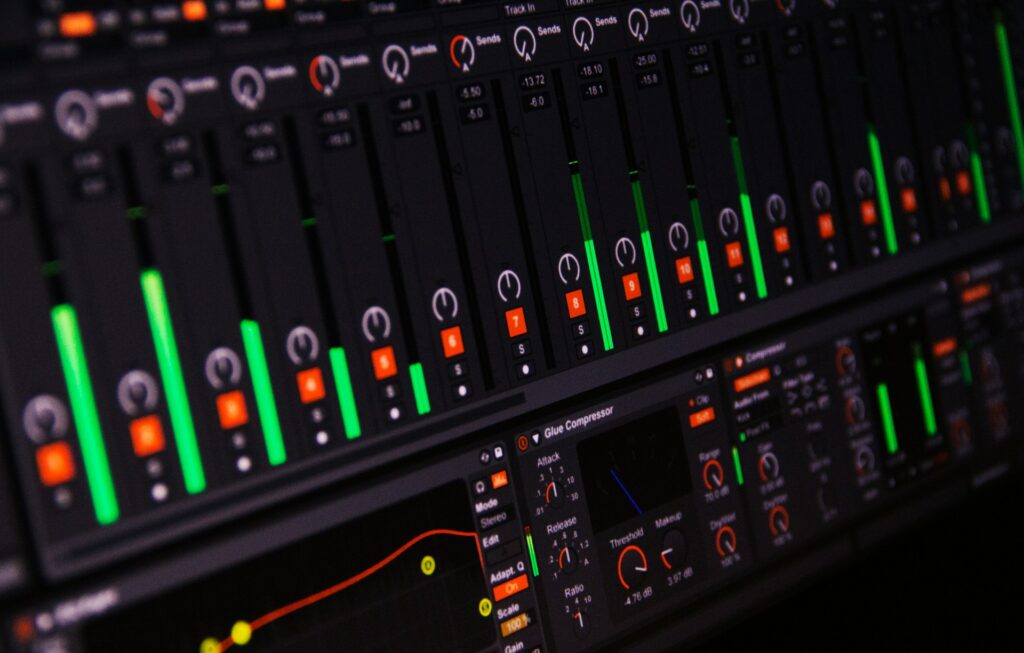
7. DAW
This is the heart piece of the studio on the software side. The DAW (Digital Audio Workstation) handles all the production, recording and mixing tasks of your audio project. Which specific software you go for depends on which features you need, and which workflow suits you best.
Judging from the full-featured versions of each major DAW (not stripped-down ones), each one of them will enable you to get your project done – the choice is mainly just a matter of taste. If you’re just starting out, it will matter even less because you’ll have to get used to it anyway.
There are some things to consider, though, especially if you want to collaborate with other musicians, studios, or producers/engineers. Avid Pro Tools is still a studio standard, so if you want to send full sessions (not just audio files) to producers or studios, this DAW is your best bet. However, this might be less of an issue than you think, because for a typical mixing service you can always just send the raw, consolidated audio files from each track (multitrack).
For all other DAWs, my recommendation is: Go for one of the major ones. For rock and metal genres, these are typically: Presonus Studio One, Steinberg Cubase, Apple Logic, and maybe Reaper. Before you decide on one, look up their features and what the workflow for recording and editing looks like. And keep in mind that Logic locks you into using only Mac computers simply because of its Mac-only compatibility.

8. Plugins, virtual instruments and amp simulations
While all modern DAWs come with plenty of stock plugins already, you might still need third-party software for some production purposes. This is less of an issue if you’re strictly recording acoustic instruments and vocals. But for production purposes or if you need virtual gear as a substitute or complement, there’s great software out there that will be beneficial to you. Some examples and recommendations for common use cases:
Songwriting/Producing:
- Drums:
- Toontrack EZDrummer / Superior Drummer
- XLN Audio Addictive Drums
- BFD3
- Bass:
- Toontrack EZBass
- IK Multimedia Modo Bass
- Keys: Toontrack EZKeys
- All-around virtual instruments: Native Instruments Komplete
Producing/Recording:
- Guitar Amp Simulation:
- Neural DSP Archetype Nolly, Plini, Gojira (X), Fortin, Cory Wong (and many more, depending on your style of music; demo for yourself!)
- STL Tonality, Tonehub
- Bass Amp/Distortion:
- TSE BOD (free!)
- Neural DSP Darkglass Ultra, Parallax
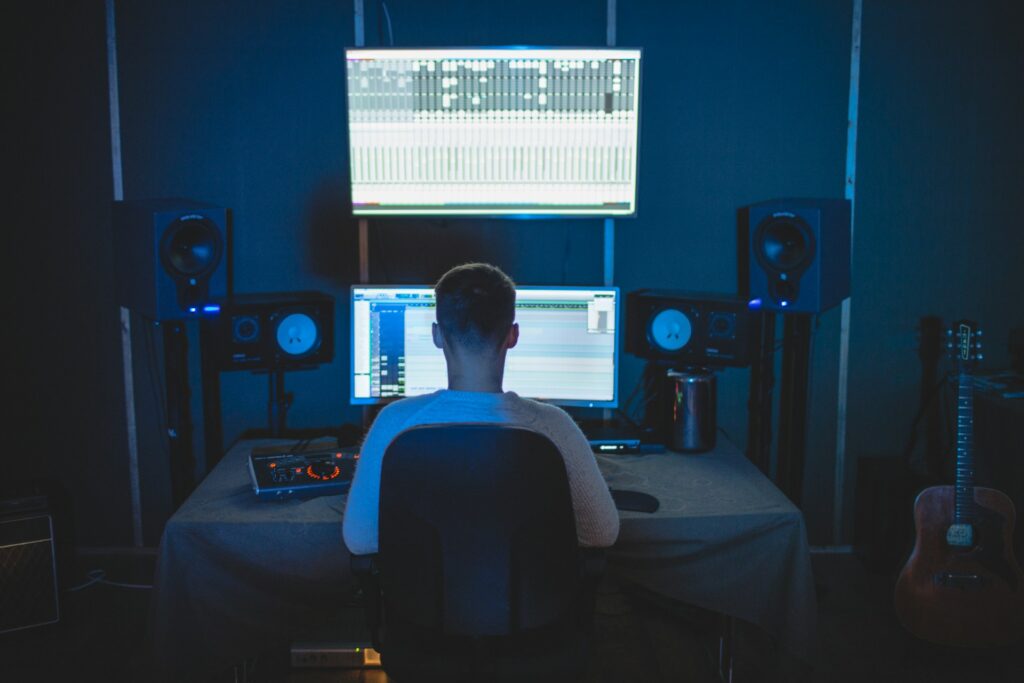
9. Studio monitors
This is a topic that deserves its own article, but very quickly: You don’t need to obsess over getting the best possible monitors if you’re not mixing and mastering on a professional level. You basically just need to hear everything that’s going on in your production and be able to judge the quality the recorded performances.
An entry to lower midrange level monitor will be sufficient for this. Ideally, you would listen to different models with music you’re very familiar with before buying. Here are some recommendations for studio monitors:
- Yamaha HS7
- ADAM T7V
- JBL 306P MKII
- Kali Audio IN-8 2nd Wave
- Monkey Banana Turbo 6
- Dynaudio LYD-7
10. Recording headphones
Every artist needs a pair of headphones to properly hear the song as well as themselves when recording. Since you don’t want any sound to get from the headphones back to the microphone, they need to be closed-back headphones. These models are some popular choices:
- Beyerdynamic DT770
- Audio-Technica ATH-M50 X

Raphael Arnold
Audio Engineer | Producer
Are you interested in my studio services? Click the button below to get to the home page for details, my portfolio, and bio.
